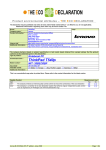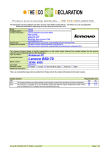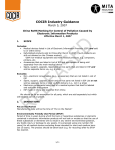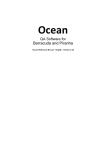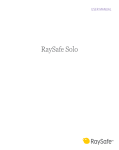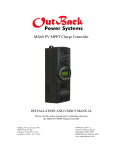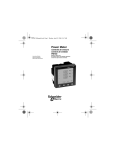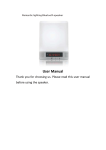Download CT - Measurement of the energy consumption
Transcript
COCIR SELF-REGULATORY INITIATIVE FOR MEDICAL IMAGING EQUIPMENT COMPUTED TOMOGRAPHY MEASUREMENT OF ENERGY CONSUMPTION Revision: 0 Date: March 2013 Approved: March 2013 12 March 2013 - Draft for discussion Self-Regulatory Initiative for Medical Imaging Equipment CT – Measurement of energy consumption – Revision V0 TABLE OF CONTENT 1. INTRODUCTION ................................................................................................... 3 2. SCOPE .................................................................................................................. 3 3. DEFINITIONS ....................................................................................................... 4 4. SYSTEM POWER MODES ....................................................................................... 5 5. USE MODES OVERVIEW ........................................................................................ 5 6. EXAMINATION DISTRIBUTION AND SCAN PROTOCOLS ......................................... 6 7. RESOURCES ......................................................................................................... 6 8. UNIT UNDER TEST (UUT) ...................................................................................... 6 9. POWER MEASUREMENT DEVICE ............................................................................ 7 10. MEASUREMENT OF POWER ................................................................................... 8 10.1. TRANSITION OFF-TO-IDLE AND IDLE POWER MEASUREMENT ................................................ 8 10.2. TRANSITION IDLE -TO-OFF MEASUREMENT ....................................................................... 9 10.3. SCAN MODE ENERGY MEASUREMENT ......................................................................... 9 10.4. TRANSITION 10.5. TRANSITION LOWPOWER -TO-IDLE IDLE -TO-LOWPOWER MEASUREMENT .......................................................... 9 MEASUREMENT .............................................................. 9 11. ENERGY CONSUMPTION CALCULATION............................................................... 10 12. COCIR CT DATA COLLECTION SPREAD SHEET ..................................................... 10 CT Energy Measurement, Revision 0, March 2013 © COCIR 2 / 10 Self-Regulatory Initiative for Medical Imaging Equipment CT – Measurement of energy consumption – Revision V0 1. INTRODUCTION The Energy-related Products (Ecodesign) Directive, 2009/125/CE, enables the European Commission (EC) to set Ecodesign requirements through new regulations for any group of products which uses energy or is related to energy consumption. In 2007, Medical Devices were identified as a “Priority A” product group by the European Commission for future regulation. COCIR Companies presented in 2009 a Self-regulatory Initiative for Medical Imaging Equipment, driven by the Ecodesign Steering Committee, committing to improve the environmental performances of their products. As the Steering Committee has done for magnetic resonance, a working group was formed to determine a measurement methodology and ecodesign targets for computed tomography (CT) from manufacturers of these systems. The outcome of the group was an agreed upon procedure for measuring typical energy consumption of CT equipment. This procedure defines specific states of system operation and instructions for determining a set of scanning protocols to be analysed. 2. SCOPE This methodology can be used to measure all CT systems. Equipment and accessories beyond a basic CT product and not required for a basic scan, or customer-provided equipment, such as optional reconstruction hardware, patient vital signs accessories, facility-provided cooling equipment and hardware for advanced medical applications are outside the scope of this procedure. It is not intended for use on interventional CT equipment. The methodology is not suited for the measurement of technologies combining CT with other imaging modalities, such as CT/PET. CT Energy Measurement, Revision 0, March 2013 © COCIR 3 / 10 Self-Regulatory Initiative for Medical Imaging Equipment CT – Measurement of energy consumption – Revision V0 3. DEFINITIONS 12h day-time: time from 7 am to 7 pm. 12h night-time: time from 7 pm to 7 am. Energy: The capacity to do work. In this document, the unit of energy is kilowatthours (kW∙h). Power: The rate at which energy is generated or consumed. In this document, the unit of power is kilowatts (kW). Procedure Type: An examination is a collection of scans for an individual patient. “Procedure Type” refers to an exam for a specific anatomy or type of exam. (e.g. Abdomen or Vascular). Off: The system is shut down, AC mains off, according to the user manual. The system consumes no energy. Low-power: The system functions into the minimum energy consumption state that the user can select according to the user manual. Idle mode: A state of the system when fully powered but no scan has been prescribed. This mode does NOT include x-ray tube rotor or gantry rotation. Scan mode: A state of the system between individual scans and during scans (e.g. during patient handling, examination planning, contrast agent injection and active scanning with x-ray generation). This mode includes tube rotor rotation, gantry rotation and generation of image, and any possible idle between scans. CT Energy Measurement, Revision 0, March 2013 © COCIR 4 / 10 Self-Regulatory Initiative for Medical Imaging Equipment CT – Measurement of energy consumption – Revision V0 4. SYSTEM POWER MODES The operation modes are defined as “Off”, “Low power”, “Idle”, and “Scan”. The energy consumption differs between the modes and the transition between modes occurs by operator selection. The anticipated power of these modes, from high to low, is: Scan > Idle > Low power > Off The table below shows a possible state transition order, for a CT system. Initial State Off / Low-power Idle Scan Idle Transition To Idle Scan Idle Off / Low Power Method Operator starts system Operator starts a scan Scanning completes Operator selection 5. USE MODES OVERVIEW Typical daily system operation is set as follows: Time period Mode Duration 12h night-time Off or Low Power 12 hours 12h day-time Idle and Scan 12 hours The typical daily energy consumption of a CT system is the sum of the energy consumption for each of the two time periods. CT Energy Measurement, Revision 0, March 2013 © COCIR 5 / 10 Self-Regulatory Initiative for Medical Imaging Equipment CT – Measurement of energy consumption – Revision V0 6. EXAMINATION DISTRIBUTION AND SCAN PROTOCOLS Within each procedure type, the specific scan parameters representing each exam type have been chosen to harmonize across manufacturers to general values as follows: Table 1: Exam Protocols Scan type Head Chest Spine Abdomen Kv 120 120 120-140 120 mA 200-300 100-250 300 187-400 Rotation speed 0,5-1 0,5 1 0,5-0,8 CTDI Maximum 60 8 25 15 Scan Length (mm) 200 200 200 200 Reconstruction jobs 1 1 1 1 ON ON ON ON Tube current modulation 7. RESOURCES The following personnel are recommended: An engineer or technician familiar with the power distribution of the system and power electronics safety. An engineer or applications specialist familiar with scanner operation and the prescribing of clinical protocols. 8. UNIT UNDER TEST (UUT) System Configuration: System configuration should be recorded and configured to perform the set of specified procedures with appropriate mandatory equipment. System Voltage: The system should be installed according to the manufacturer’s installation instructions at an input voltage of 380-415 VAC. Installation: The system shall be installed and calibrated according to its specification, including all system-critical items needed to perform a basic scan, e.g. gantry, x-ray generator and tube, reconstruction engine(s), required electronics such power supplies, controllers, console/computer, and patient table. Any equipment and accessories beyond the basic product offering that is not required for a basic scan (e.g. customer-provided equipment, optional Supplier equipment such as patient vital signs accessories, hardware for advanced medical applications, etc.) shall not be included in the measurement. Environmental Conditions: The measurements are to be taken at a steady-state operating temperature within manufacturer’s specified ambient temperature and humidity limits. CT Energy Measurement, Revision 0, March 2013 © COCIR 6 / 10 Self-Regulatory Initiative for Medical Imaging Equipment CT – Measurement of energy consumption – Revision V0 Measurement: Prior to each mode’s measurement, the equipment shall remain in that mode for sufficient time to allow temperature and other pertinent transient conditions to stabilize, except when measuring transient conditions (Off/Low-power to Idle and Idle to Off/Low-power) . Phantoms: For the scan a 200-350mm water/polypropylene phantom shall be used, so that the spiral scan is not performed without any structure in the scan beam. 9. POWER MEASUREMENT DEVICE The measurements shall be recorded using a device capable of measuring 3-phase voltage and current, and calculating the integral of power with respect to time (energy) or a power meter able to sample average power ratings. Figure 1: Power usage of a CT scanner over 24 hours. The level of the low power mode depends on the specific CT models and technology. The power measurement device shall be installed onto the input to the AC Mains disconnect panel of the system to ensure that all energy consumption of the CT equipment is captured, including any cooling equipment provided by the CT supplier as part of the base system. CT Energy Measurement, Revision 0, March 2013 © COCIR 7 / 10 Self-Regulatory Initiative for Medical Imaging Equipment CT – Measurement of energy consumption – Revision V0 10. MEASUREMENT OF POWER Trial executions of testing showed a further simplification of the test procedure is possible by approximating the range of protocols by only the Abdomen scan. Setting up Scan Protocols Prepare the abdomen scan protocols provided by the CT scanner (e.g. “abdomen routine”, “abdomen standard”, …) according to the user manual using the parameters defined in section 5 . If it is not possible for the CT system under test to use a certain sequence or specified value, use a sequence or value as close as possible to the sequence specified given the same diagnostic results. The power measurement of different system states, transitions etc, described in the following sections shall finally allow to calculate the complete 24h power consumption according to figure 2. Figure 2: exemplary power usage of CT scanner for calculation of daily energy consumption. The figure reports also variable idle power. 10.1. TRANSITION OFF-TO-IDLE AND IDLE POWER MEASUREMENT 1) Shut the system to Off mode according to the user manual. 2) Wait to ensure that all system elements have established a static Off power operation 3) Start the power measurement on the measurement device. 4) Then switch on the CT system to idle according to the user manual. The measurement device now records the complete transition from Off state to Idle state (energy consumption of transition Off-to-Idle) 5) Record Eoff-idle (Energy from Off to Idle) [kWh] 6) Record total transition time, T off-idle [h] 7) Record the power consumption in Idle state (Idle power consumption) in kW CT Energy Measurement, Revision 0, March 2013 © COCIR 8 / 10 Self-Regulatory Initiative for Medical Imaging Equipment CT – Measurement of energy consumption – Revision V0 10.2. TRANSITION IDLE-TO-OFF MEASUREMENT 1) Allow the system to stabilize in Idle mode then start the power measurement on the measurement device. 2) Shut the system to Off mode according to the user manual (no energy consumption). 3) The measurement device now records the complete transition from Idle state to Off state (energy consumption of transition Idle-to-Off) 4) Record Eidle-off (Energy from Idle to Off) [kWh] 5) Record total transition time, T idle-off [h] 10.3. SCAN MODE ENERGY MEASUREMENT 1) Begin kWh datalogging at time T=0. 2) Prescribe a patient and begin an abdomen exam according to Table 1, Exam Protocols. 3) Allow the exam to complete normally. 4) Let the system run until time T=35 minutes. 5) Record the total energy in kilowatt-hours. 6) Record the scan energy EA in kWh. 10.4. TRANSITION IDLE-TO-LOWPOWER MEASUREMENT 1) Allow the system to stabilize in Idle mode, then start the power measurement on the measurement device. 2) Switch the system to LowPower mode according to the user manual. 6) After a static LowPower state is reached, stop the power measurement on the power measurement device. The measurement device now records the complete transition from Idle state to LowPower state (energy consumption of transition Idle-to-LowPower) 7) Record Eidle-lowpower [kWh] 8) Record total transition time, T idle-lowpower [h] 9) Record the power consumption in Idle state (Idle power consumption) in kW 10.5. TRANSITION LOWPOWER-TO-IDLE MEASUREMENT 1) Allow the system to stabilize in LowPower mode, and then start the power measurement on the measurement device. 2) Switch the system to Idle mode according to the user manual. 3) After a static Idle state is reached, stop the power measurement on the power measurement device. The measurement device now records the complete transition from LowPower state to Idle state (energy consumption of transition LowPower-to-Idle) 4) Record Elowpower-idle [kWh] 5) Record total transition time, T lowpower-idle [h] CT Energy Measurement, Revision 0, March 2013 © COCIR 9 / 10 Self-Regulatory Initiative for Medical Imaging Equipment CT – Measurement of energy consumption – Revision V0 11. ENERGY CONSUMPTION CALCULATION The 24h energy consumption according to figure 2 has to be calculated out of the measured power and energy consumption of the different system states and transitions, with the following formula for the 3 scenarios: Scenario Off: The CT scanner is in Off mode for 12h during night time Etot = Eoff + Pidle x 20mins + 20 x EA Scenario Idle: The CT scanner is in Idle mode for 12h during night time Etot = Eidle (12h) + Pidle x 20mins + 20 x EA Scenario Low : The CT scanner is in LowPower mode during 12h night time Etot= Elowpower + Pidle x 20mins + 20 x EA Where: ‒ ‒ ‒ ‒ Eoff Eidle Elowpower Pidle 12. : : : : Eidle-off + Eoff-idle Energy in Idle mode over 12h night time Eidle-lowpower + Pidle * (12h - Tidle-low – Tlow-idle) + Elowpower-idle Power in Idle mode COCIR CT DATA COLLECTION SPREAD SHEET The data obtained according to the present methodology have to be filled in the appropriate template that can be downloaded from the COCIR website www.cocir.org for the calculation of the energy consumption in the different scenarios. CT Energy Measurement, Revision 0, March 2013 © COCIR 10 / 10 “Self-regulatory Initiative for medical imaging equipment” Copyright © 2011 COCIR All Rights Reserved. All material in this document is, unless otherwise stated, the property of COCIR. Copyright and other intellectual property laws protect these materials. Reproduction or retransmission of the materials, in whole or in part, in any manner, without the prior written consent of the copyright holder, is an infringement of copyright law.













